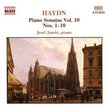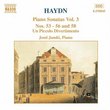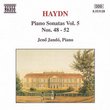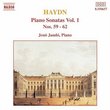| All Artists: Franz Joseph Haydn, Jenö Jandó Title: Haydn Piano Sonatas, Vol. 2 Members Wishing: 0 Total Copies: 0 Label: Naxos Release Date: 10/18/2002 Genre: Classical Styles: Forms & Genres, Sonatas, Historical Periods, Classical (c.1770-1830), Symphonies Number of Discs: 1 SwapaCD Credits: 1 UPC: 730099584425 |
Search - Franz Joseph Haydn, Jenö Jandó :: Haydn Piano Sonatas, Vol. 2
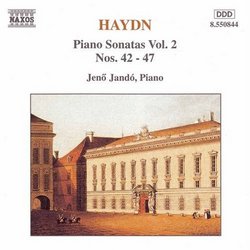 | Franz Joseph Haydn, Jenö Jandó Haydn Piano Sonatas, Vol. 2 Genre: Classical
|
Larger Image |
CD DetailsSimilar CDs |
CD ReviewsJand�'s Haydn -- Sheer Delight Coupled with Intensity. am@diakrisis.org | Netherlands | 08/11/2000 (5 out of 5 stars) "Until I heard Jenö Jandó's recordings of Haydn's Piano Sonatas, I had found them rather dull and lacklustre. I now realise that the reason for this is that a piece does not properly come alive until a performer puts away his or her ego and plays as the composer wants it played (Alfred Brendel take note!). Surely this is precisely what Jandó does. I remember the moment that I first heard Jandó's interpretation of Haydn. It was on a program of new releases on BBC Radio 3. Within seconds, I was on the edge of my seat, laughing with joy, with tears in my eyes. This is how it should be played! I wanted to write to Jandó immediately and tell him how grateful I was to him for opening my eyes to the beauty of Haydn. What a delight it was to discover that Haydn had written 62 piano sonatas for us to spend time exploring. One finds here a pleasing mixture of the influences of the perfectionist Scarlatti and the Sturm und Drang composer C.P.E. Bach, with Haydn's own hallmarks added. According to Robbins Landon, Haydn used to pray to God every morning for inspiration before he began composing. He certainly received it! Although Volume 1 contains the last four sonatas (which are arguably the best), this Vol. 2 is also full of great things. It would take more space than I am permitted if I was to review all the sonatas on this CD, but I will make special mention of No.47 in B minor, as it was this very sonata which so moved me on that radio program. This is an astounding piece, and wonderfully played by Jandó with real intensity. The first subject of the first movement is unusual, with a dark left hand motto hammering away underneath. One of the principal characteristics of Haydn's piano sonatas is the way that he screws up the tension at the end of the development section of the first movements on the way to the recapitulation. This is again the case in the B minor sonata. A lovely aspect of Haydn's piano sonatas is the jewel-like clarity of one's place in the music. Everything is so shiningly laid out that you always know just where you are; and because of the telescoped brevity (mostly 3 to 4 minutes), each sonata first movement is like a microcosmic world in itself. Development sections are often so short -- even shorter than the exposition! Yet everything is in its place and perfect. Anyone familiar with these pieces will know exactly what I mean. At the end of the coda of this first movement -- for all its B minor intensity -- one feels a sense of accomplishment and excellence as the final minor chord is hammered out. The slow movement -- something of an intermezzo -- is in minuet form, remarkable for its nervous little trio in the minor key. It is in the Presto finale that the power of the piece breaks out. This is the moment for virtuosity to fly. In just three minutes, Haydn (with Jandó's able help) takes us on an exhausting journey at breakneck speed. Again, as in the first movement, the left hand figures strongly as a descending forte bass line is etched into the heart of the listener. Composers usually mean business when they compose in the key of B minor. Jandó plainly recognises this; and one is left with the impression that he has pulled out all the stops -- not only for this final Presto movement, but for the entire piece. This ten minute sonata is the one with which to turn skeptics on to Haydn. My wife is a cellist and vary rarely plays anything on the piano. But after sharing my joy in Jandó's Haydn, she couldn't wait to obtain the score to play them through herself. I hope I have enthused enough to inspire you to do likewise! It is fair to point out that Richard Brautigum has begun an excellent series of these sonatas on an old fortepiano (also available from Amazon). Period instrument freaks will delight in his definitive performances. But out of all the versions on a modern instrument, Jando is definitely the pianist to go for. The acoustic of the Unitarian church in Budapest is bright and responsive. Five stars, without hesitation." The playing is graceful, trim and alert. John Austin | Kangaroo Ground, Australia | 02/17/2001 (5 out of 5 stars) "Naxos numbers these sonatas as 42 to 47 in their series of the complete keyboard sonatas of Haydn, played by Jenö Jandó. They were written by Haydn between 1774 and 1776, and originally published as a set of six. During these same years Mozart also composed six keyboard sonatas, K. 279 to K 284. The Haydn set is particularly interesting and rewarding for both player and listener. Haydn was discovering ways of providing interest in all parts of the musical texture, from bass to treble, disposing almost entirely of the broken chord pattern that had formerly occupied the left hand throughout. I haven't compared Jandó's Haydn series with those of other pianists, but I am certainly happy to own all that have been issued in his series so far. The playing is graceful, trim and alert. The sonatas in Volume 2, each in a different key, were recorded in 1993, and the total listening time is 72 minutes." Exploring Haydn's Sonatas -- Nos. 42 -- 47 Robin Friedman | Washington, D.C. United States | 09/12/2009 (5 out of 5 stars) "Between 1774 -- 1780, Haydn published three sets of six piano sonatas. The first set of six, dedicated to Prince Esterhazy, was the first authorized publication of any of Haydn's works. It is available as volume 4 in the individual CD's of Jeno Jando's outstanding Haydn cycle, or as part of the box set that Naxos recently issued. The CD I am reviewing here consists of Jando's rendition of the second of the three sets of sonatas. The six sonatas included here were probably composed between 1774 -- 1776. They were published privately in 1776 before they appeared publically in an edition published in Hummel in 1778 and designated as Haydn's opus 14. Some of the sonatas are performed on occasion on single CDs devoted to Haydn. For example, Marc Andre-Hamelin performs one sonata from this group on each of his two two-CD recordings of Haydn sonatas. But it is rare to hear the entire set played on a single CD.
The sonatas in this group are varied and delightful. They exemplify early classical galantrie and balance and show the great influence of Scarlatti as well as the more frequently noted influence of C.P.E. Bach. The sonatas have strong rhythms, lyrical themes, humor, and balance among their movements. They do not wear their hearts on their sleeves and they have little in the tendency towards self-aggrandizement. With one exception, each of these sonatas is in three movements; and, again with one exception, each is in the major key. Jando does not have the virtuosity of Hamelin, but he plays these sonatas with style, elan, and effectiveness. His recordings are outstanding guides to the world of the Haydn sonata. I listened to these works in the company of the inexpensive two-volume Dover edition of Haydn's sonatas. The first three sonatas conclude the first book, while the second three sonatas begin the second book. Here are some short descriptions of the individual sonatas. The opening sonata in G major begins with a lighthearted allegro con brio highlited by a lyrical second theme. The development section of the movement is in the minor and reminded me of the "Mannheim Rocket" phrase that Mozart used in the finale of the g-minor symphony. The second movement is a minuet, also in G major, but with a contrasting trio in the minor. The work concludes with a presto based upon a short lively phrase which is repeated, varied, and embellished as the movement proceeds. The first movement of the sonata no 28 in E-flat major has a syncopated, rhythmic theme characteristic of Haydn. Note how the flow of the movement is interrupted, both in the exposition and recapitulation, by a short adagio passage. There are some surprising minor key passages in the development of the movement. The second movement is a minuet with running triplets and a minor-key trio. The work concludes with another rapid-fire conclusion based primarily on a single, varied theme. The sonata no 29 in F major begins with an opening moderato movement which begins with distinctive, large chords with passages of strongly repeated notes. It is contrasted with a lighter theme. The second movement is a lovely, extended adagio (the first adagio movement in this set), and the sonata concludes with a minuet with contrasting major key and minor key sections. Although sonata no 30 in A major has only two movements, it is unusual in that the opening movement, marked allegro, concludes with a substantial adagio section. This gives the sonata the feel of a three-movement work. The sonata begins with a light, embellished theme. It soon assumes a march-like character with a great deal of vigor and swagger before the appearance of the reflective adagio which concludes the movement. The adagio features broken chords deep in the lower register of the piano. The work concludes with a minuet which Haydn combines with a set of six variations. The sonata no. 31 in E-flat major is one of the better-known works of this set. Marc-Andre Hamelin performs it to open his more recent set of Haydn sonatas, and I have also enjoyed it in a recent recording of Haydn by the Turkish pianist Fazil Say. The work opens with a lively movement in counterpoint with much syncopation and many long runs over the keyboard. The second movement, alegretto, has been compared to Bach's Three-Part Inventions, as it features a chordal, solemn theme in a baroque style. The movement leads without pause to a virtuosic mostly gay presto but with a sharply contrasting minor-key middle section. The concluding sonata, no 32 in b minor, is the most famous work of this set. Hamelin plays the work in his earlier Haydn recording, and it is also performed frequently on other CDs of Haydn sonatas. The outer movements of this work are percussive, angular and stormy. They remain unremittingly in the minor key Haydn uses repeated notes, strongly syncopated rhythss, lengthy passages in octaves, and especially in the finale, dramatic pauses to create a work of passion, force, and tension. Only in the intervening minuet does Haydn briefly lighten the atmosphere of this sonata; and even this movement reinforces the stormy character of the work with its minor-key trio. This is an excellent CD for those listeners with the commendable ambition to explore Haydn's piano sonatas in detail. It is available singly or as part of the recent Naxos box set which includes the complete cycle of Haydn sonatas performed by Jeno Jando. Robin Friedman " |

 Track Listings (17) - Disc #1
Track Listings (17) - Disc #1